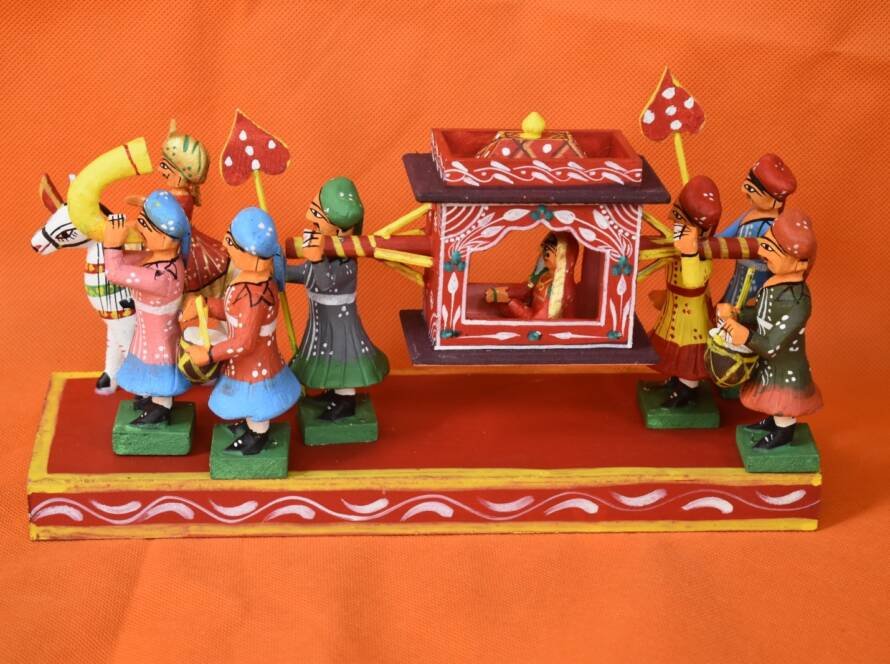Walls That Whispered: A Heartfelt Beginning
In the mud homes of Mithila, when the walls spoke, they spoke in the voices of women. Not loud or declarative, but rhythmic, like a lullaby passed from mother to daughter. With fingers dipped in rice paste, twigs soaked in natural dye, and hearts full of untold stories, generations of women transformed plain surfaces into sacred canvases — painting not just deities and rituals, but dreams, griefs, and celebrations.
Madhubani, or “forest of honey,” as the name suggests, isn’t just a folk art form — it’s a living, breathing language of feminine resilience, devotion, and creative freedom. Every line drawn was a testimony. Every motif, a memory.
A Tradition Rooted in Ritual and Reverence
The origins of Madhubani are wrapped in legend. It is said that when King Janaka of Mithila commissioned artists to paint his daughter Sita’s wedding to Lord Rama, a tradition was born. But the real keepers of this legacy weren’t court painters — they were village women, painting on walls during births, marriages, and festivals, invoking gods not through chants, but through intricate patterns and colors.
Madhubani was not ‘art’ in the modern sense — it was a form of sacred participation. A woman painting Krishna on her courtyard wall wasn’t decorating; she was offering. A fish drawn near the door wasn’t ornamental; it was symbolic of fertility, life, and abundance.


Women as Custodians of Culture
What makes Madhubani extraordinary is not just its style — the bold black outlines, the fine detailing, the symmetry — but the fact that it was almost entirely preserved and passed on by women, many of whom had little access to formal education.
Through painting, they preserved stories — of gods, nature, cosmic cycles, and social customs. In a patriarchal setting where voices were often silenced, the brush became a tool of expression. These women narrated epics not with words, but with color. Their walls were journals, temples, and testimonies — all at once.
Over time, their work moved from walls to paper, canvas, and even sarees. Yet, the soul remained intact.
A Palette of Symbols and Beliefs
In Madhubani, nothing is random. Every symbol carries meaning. Peacocks for love. The sun and moon for time and divinity. Bamboo trees for resilience. Lines are often double-bordered — as if protecting the sanctity of what lies within.
Natural colors were originally made from turmeric, indigo, neem, and soot. The act of making color was itself meditative. Applying it was an act of devotion. In many ways, Madhubani was — and still is — a spiritual practice as much as a visual one.
Why It Still Resonates Today
In today’s fast world, where we often seek identity in external things, Madhubani gently invites us inward — to reconnect with roots, rhythm, and ritual. It reminds us that expression needn’t be loud to be powerful. That art can bloom even in the humblest homes. And that culture is often safeguarded not in institutions, but in lived, everyday gestures — a woman painting by the morning light, children watching, learning, continuing.
The rise of contemporary Madhubani artists — many of them women — reflects how this tradition still empowers, still tells stories that matter, and still finds relevance in modern conversations around identity, ecology, and gender.
Closing Reflection: Carrying the Flame
Madhubani is more than pigment and pattern. It is a quiet revolution. It is what happens when art grows out of faith, when creativity becomes a lineage, and when women — generation after generation — choose to express instead of suppress.
As we stand before a Madhubani painting today, we are not just admiring an artwork. We are listening. Listening to centuries of women who painted not to impress, but to express. Not to be seen, but to be remembered.
May we carry their legacy — with respect, pride, and a deep sense of wonder.



